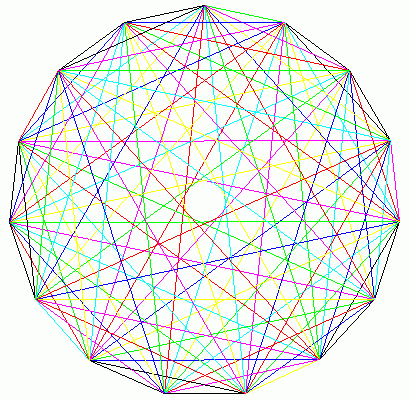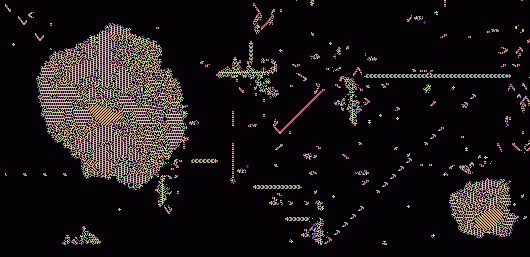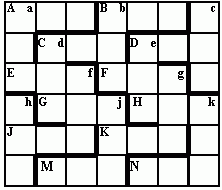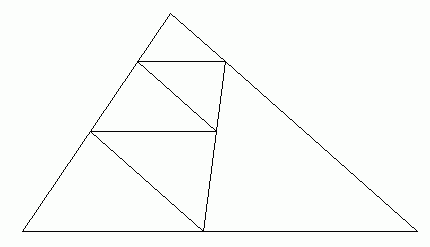material added 21 October 2002
A trapezoid has sides of 13, 5, 11, and 8.
The diagonals also have integer length. What are they? Answer and solvers. I'm fairly certain
that this is the smallest quadrilateral with 6 different integers for
the sides and diagonals. Robert Reid sent me the 25, 39, 60, 52
quadrilateral, which has perpendicular integer diagonals. He
hypothesized, in 1972, that this was the smallest such. Claudio
Baiocchi disagreed, and sent me a smaller nonconvex
example.
Robert Reid: "On the island of Plunk the only straight edges they have are on quadrilateral pieces of slate. Strangely enough, the side lengths are always integral multiples of their unit of measurement. The slate is extremely hard, so they make rulers with only 6 marks, (one on one edge, two on the next, three on the third and none on the fourth). Amazingly, they can measure all lengths from one to twenty. What are the possible quadrilaterals, and how are they marked?" Answer.
At the La Jolla Covering center, I noticed
cyclic coverings. A cyclic cover starts with a polygon where the sides
and diagonals all have different length. I hand-solved the quadrilateral
in a 13-gon, it is a nice puzzle. Try it! Here are the solutions for the
pentagon in a 21-gon, and a hexagon in a 31-gon. Repeat 21 or 31 times,
and you get the full graph. This, and Reid's problem, are related to Golomb
Rulers.

A quickie by Michael Riemann: 69 squared
is 4761. 69 cubed is 328509. Each number from 0..9 appears
exactly once. Now, find a number so that the third and fourth powers
have this property. Answer. Igor Krivokon: I solved it
using this Perl one-liner:
++$i while length($_=$i*$i*$i.$i*$i*$i*$i) != 10 || /(.).*\1/;
print $i
An antique with lots of secret
compartments is demonstrated at Clip
4, here. You can't buy that, but there are a lot of things you can
buy at Mr. Puzzle, Kadon Enterprises, Cleverwood, and Funagain Games.
The latter has the complete Games 100 on sale.
One of the champions of Mathematical
Recreations is G P Jelliss, so you might like his website.
I mentioned weeks ago that Patrick Hamlyn's 30-60-90 partridge puzzle
was offered by Walter Hoppe. A paper version is here --
arrange the 10 triangles to make a 30-60-90 triangle. Patrick sent me
a nice picture of his copy. If you'd like one, send a check to:
Walter H. Hoppe, 3648 Tolland Road, Shaker Heights, OH 44122-5141. You
can see samples of his work at Puzzle
World . His aol.com address is LaserLynne.

material added 13 October 2002
PQRST
03 has just started. You have six days to send answers and ratings
of 10 puzzles. At Cihan Altay's WPC-2002 page, you can
find links to 5 trip reports.
Fifteen golfers want to get to know each other, so they play in groups
of three for a week. (15-3-7) By the end of the week, all the golfers
have played once with each other. This particular setup is
identical to the Kirkman
Schoolgirl Problem. It is also an example of a Golf Tournament
Problem. I realized that the answer to this problem might make a
nice picture. For example, 16 golfers playing in groups of four for five
days (16-4-5) can be done as follows:

Andy Liu and Michael Reid let me know that the above can be solved as a finite affine
plane. If you look for similar designs in the La Jolla Covering Repository,
you'll see these particular systems are solved via affine geometry.
Twenty five golfers playing in groups of 5 for 6 days (25-5-6) can be
done as follows:

I thought that 36 golfers might be able to
play in groups of 6 for 7 days, but that winds up being impossible.
If it were, then the first 4 days could be used as a solution for
the 36
Officer Problem. Euler's
Graeco-Roman square conjecture is related. Twenty seven golfers
playing in groups of three for 13 days (27-3-13) can be done as follows
(the thirteenth picture has groups 1-2-3, 4-5-6, etc):

As a puzzle, you might try to find a
symmetric picture for 9 golfers in threesomes for 4 days. Here is the answer. Now, you might be
wondering about the 15-3-7 problem I started with. Despite my efforts, I
could not find a symmetrical picture for it. Let me know if you can find one.
Below is my best effort. Other groups that seem to be unsolved are
21-3-10, 28-4-9, 33-3-16, 40-4-13, 45-3-22, 45-5-11, 49-7-8, 52-4-17,
64-4-21. If you can solve any of these, or improve the bounds, let Warwick know.

The Kirkman Schoolgirl Graph. Can it be made symmetrical?
material added 8 October 2002
David Wilson recently asked me whether a square or general triangle could be divided into acute isosceles triangles. I managed to divide the 2-3-4 triangle into 17 such triangles, and I divided the square into 16 acute isosceles triangles. Can these be beat? Let me know. Maybe these can be improved. If you are new to this type of problem, you might like trying to divide a square into 8 acute triangles, or 9 (harder). (Gardner presented solutions for both of these.) Footnote: Dan Hennessy let me know that V.E. Hoggatt Jr., and R. Denman, "American Mathematical Monthly," Nov. 1961, p. 912-913 shows that any obtuse triangle can be divided into 8 acute isosceles triangles. R. William Gosper found better solutions for both. His solution for the square in 10 acute isosceles triangles appears to be unique, and involves an order 12 polynomial. He verified the 2-3-4 triangle can be divided into 7 acute isosceles triangles.


The Periodic Table Table
that I helped to build and promote has won the Ignobel
Prize in Chemistry. Theo Gray wrote
up our trip to Harvard. At the awards ceremony, by an odd
coincidence I was seated right in front of a delegation from the National Puzzler's League. A few
days later, I had a chance to see MIT's infinite corridor, and the Harold Edgerton
exhibit. If you've ever seen the splash of a milk drop, or a bullet
cutting a playing card, you've seen Edgerton's work. On Saturday, Theo's
father pointed out the Deutsche
Bank Conceptual Word Search that filled up many pages of the New
York Times (I found it fairly pointless).
I rather like the Chromatron series of
mirror-based puzzles. I just started using the Mozilla editor -- let me know if you
see anything that needs fixing (I love Mozilla as a browser). Many
people sent answers to my F26 question. My own method for solving was to three-color the edges. Since most of
the figure is a hexagonal grid, three-coloring is easy. That leads to
the first solution below. The circular embeddings are what you'll see if
your straighten out the hexagonal embeddings.

material added 1 October 2002
I like symmetry, such as those seen in the graphs at the Foster Census. But they don't have pictures. You can see some of these graphs in A New Kind of Science, and I've started putting more of them on Mathworld. Graph F26 led to a neat little puzzle ... is it Hamiltonian? Yes, it is. Can you find a cycle that goes through all the vertices, without reusing an edge, and ending where you started? With the right approach (just four words!), this is very easy, and the solution is gorgeous. Answer. If you figure out my approach, just send me that.

The World Puzzle Championships were won by Japan this year. Will Shortz is getting a column in next issue of the Reader's Digest, at least until December. I'll be going to Harvard this weekend, to pick up an award at the Ignoble Prize ceremony.
Theo Gray's Wooden Periodic Table project that I Igored (which won an ignoble prize), has details of a Sodium party. Not long ago, while standing far, far away, we learned that a large piece of sodium turns into a hopping/explosive/caustic projectile, that bounces 40 feet at a time. On the whole, I preferred magnesium. I'll get a new acrylic version of the periodic table if it's available in November.

Patrick Hamlyn recently ignored a (poor) impossibility proof, and found a way to cover a cylinder with the 5 tetrominoes. Can you figure out how? Here is the answer, by Clinton Weaver. Many people solved this (it's easy).
Jim Propp (discoverer of the "highway" in Langton's Ant) tells me that I was likely the first to notice the binary counting turmite. Normally, the "turmite mound" starts out with all zeroes, but I decided to try starting with {{0, 1}, {1, 0}}. Here is what happened. I let it run for awhile -- simple counting after a detour.
material added 23 September 2002
The American Mathematical Society Notices has my review of Martin Gardner's Colossal Book of Mathematics.
In a three-coloring, such as the di-L-tetrominoes solution by Patrick Hamlyn (below), only three colors are used, and no two regions of the same color share an edge. The Penrose Tiling can be 3-colored -- This was proven by Robert Babilon [Discrete Mathematics 235(1-3):137-143, May 2001] Each kite and dart touches exactly 4 others, so I tried to expand the problem with a little conjecture: A map is 3-colorable if each interior region is bounded by an even number of sides. That's false. Dean Hickerson found a very nice counterexample. It's an 8 region map, where each region shares an edge with exactly 4 other regions. Hickerson's map requires 4 colors, so my conjecture was wrong. Can you find it, or a different counterexample? Answer. A hint: In the figure below, no more than 3 regions meet at any point, so it's called a cubic map. A cubic map is 3-colorable if and only if each interior region is bounded by an even number of sides. This is easily proven. Dean Hickerson, Clinton Weaver, Stephen Kloder and Jaap Scherphuis solved it. Another picture.

Dr. Sebastian Wedeniwski of zetagrid.net has collected the first 110 billion zeroes of the Zeta Function. He is offering various prizes that you can win by joining the grid and making mathematical discoveries. (I made a similar announcement for Eternity, and readers of this page won that prize.)
One of my favorite puzzle games back when I had a Mac+ was The Fools Errand by Cliff Johnson. I just learned that fools-errand.com is an active site by the original programmer, he's providing a number of free downloads, with PC versions of the original games.
Erich Friedman: Arrange 14 cubes so that each cube touches 6 others along some portion of a face (not just an edge or a corner). Answer. It was solved by Erwin Eichner.
A curiousity I found with Mathematica: 1183893^2 = 1!+2!+3!+7!+8!+9!+10!+11!+12!+13!+14!+15! . I greatly enjoyed reading the antics at Scam-o-rama.
material added 14 September 2002
From Federico Kereki: This problem comes "from real life" -- it was proposed to my nephew in High School, and he couldn't solve it. FIRST PROBLEM: Set 102 straight lines on a plane, so they intersect in exactly 2002 points. As it is, it's quite difficult to solve -- I guess the professor made a typo when he wrote the problem, so here is a... SECOND PROBLEM: What number would have made that a reasonable High School level problem? Pictures. Answers.
From Erich Friedman: The twelve different pentominoes have been paired up. Unpair them. (Solved by Erwin Eichner, Darrel C Jones, Clinton Weaver, and Koshi Arai)

The game of awarihas been solved by John W. Romein and Henri E. Bal , through an analysis of all 889,063,398,406 positions. It's a draw. The "perfect" playing applet is quite interesting.
From Jeff Barnes: SONGBIRD divided by BIRDSONG = OWL (a recurring decimal). What is the 8 digit number SONGBIRD? Bob Kraus sent the solution. (He used a program, just as I did).
64 squared is 4096. If you put a zero in front of that, it can be the middle entry in a 5 by 5 square of square numbers. Basically, a crossword with five square numbers reading across, five square numbers reading down, and 04096 as the third down entry. What is this grid? Answer. Matthew Bjorge solved it by hand.
George Maydwell has found a cellular automata that forms odd "iceballs", when allowed to run for a long time.

Eric Weisstein has graciously added my write-up of Turmites and Guilloche patterns (found on money, tickets, passports, and licenses worldwide) to his encyclopedia. Feel free to write me for details of the code.

Jean-Charles Meyrignac has put together a page of Solitaire problems, with a javascript implementation.
The Wooden Periodic Table project has turned up more surprises. I learned thatsodium attracts droves of sulfur butterflies. We have good samples of almost all the safe elements, now, including scandium. We still need lanthanum, terbium, homium, ytterbium, and lutetium. If you have a kilogram of 99.99% lutetium sitting around in your basement, we'd love to have it.
The German equivalent of Scientific American (www.wissenschaft-online.de/spektrum/) has a good math column. (translated by google).
John Gowland(at ampnet.co.za, jgowland, would love to see your comments) presents All 9's Squared: "You may like to consider my latest puzzle. I sent it to Oyler out of interest to get an opinion of the standard of puzzle." (Oyler liked it a lot.)



Don Knuthhas made available a work on Combinations, to join his preleases on Permutations and n-tuples. All of them can be viewed by using Ghostview and Ghostscript. All of these were updated 24 August.
Jorge L. Mireles has updated his gorgeous applet based on rotating decagons and stars. Claudio Baiocchi comments: "Thank you for signalling this. From my point of view your evaluation could in fact appear as an understatement, the puzzle being quite impressive. I noticed that a new release of the applet just appeared, offering a lot of new possibilities."
On another topic, dividing a triangle into similar but non-congruent pieces has come up. Here's a picture of the 4-5-6 triangle in 6 pieces. Michael Reid tells me the reference is h. kaiser, perfekte dreieckzerlegungen. elemente der mathematik 46 (1991), pp. 106-111. mr 92 d:51019.

material added 3 September 2002
Results of the International Puzzle Design competition are now available at www.johnrausch.com/DesignCompetition/default.htm. All of the main winners used clever mathematical tricks.
Puzzle of the week: The Lonely Unit Cube. Arrange 1 side-1 cube, 54 side-2 cubes, 24 side-3 cubes, and 2 side-5 cubes to make a side-11 cube. Answer.Second answer. (Placements of key pieces is enough) Patrick Hamlyn discovered this after I posed the harder question of whether a cube could be dissected into smaller cubes with only one unit cube. If anyone can make this puzzle out of appropriately sized dice or other objects, I'd very much appreciate a picture. Patrick found with fewer than 8 unit cubes, and a side length below 12, the set of cubes is unique.
I was looking through The Ins and Outs of Peg
Solitaire, and found this gem: ![]() . John
Beasley claims that any cell can be vacated, and for each such position,
the final peg can rest on that spot. Further, he claims no smaller
square-grid board with this property is possible.
. John
Beasley claims that any cell can be vacated, and for each such position,
the final peg can rest on that spot. Further, he claims no smaller
square-grid board with this property is possible.
The reason I was looking was the Lamp problem (Martin Gardner, Further Mathematical Diversions, p 125). The best that was done at the time was a 10-move solution. Jean-Charles Meyrignac has found a 9-move solution, where the pegs start on the x's, and the final peg is at the center of the board. Can you find it?

A book recommendation -- the next time you're travelling, ask a money-changer if they have an old issue of the MRI Banker's Guide to Foreign Currency that you may have. Another obscure favorite: Triangle Centers by Clark Kimberling. A taste for this excellent book can of course be seen at the accompanying website.
A network security book by Kaufman, Perlman, and Speciner has the dedication "Si spy net work, big fedjaw iog link kyxogy". Perlman says that it's a straight substitution cypher. Answers.
Older Material - 16 Jul 02 to 26 Aug 02
Older Material - 13 May 02 to 9 Jul 02